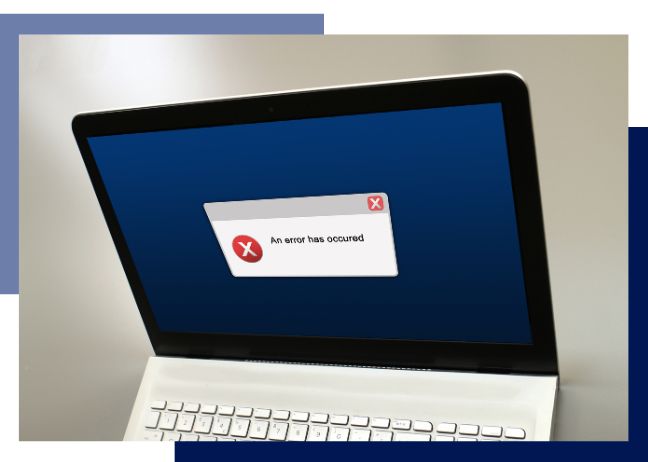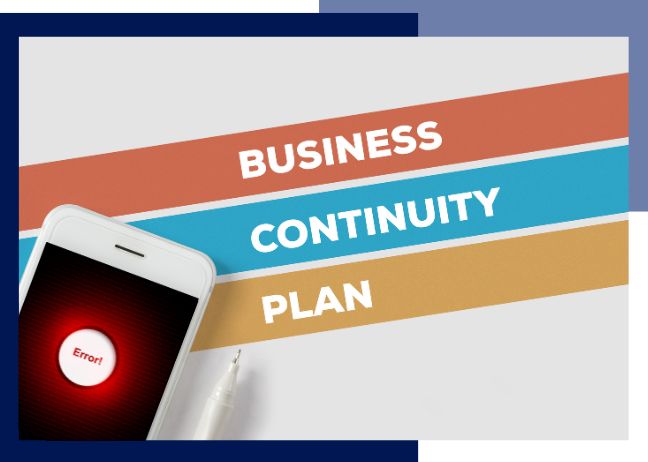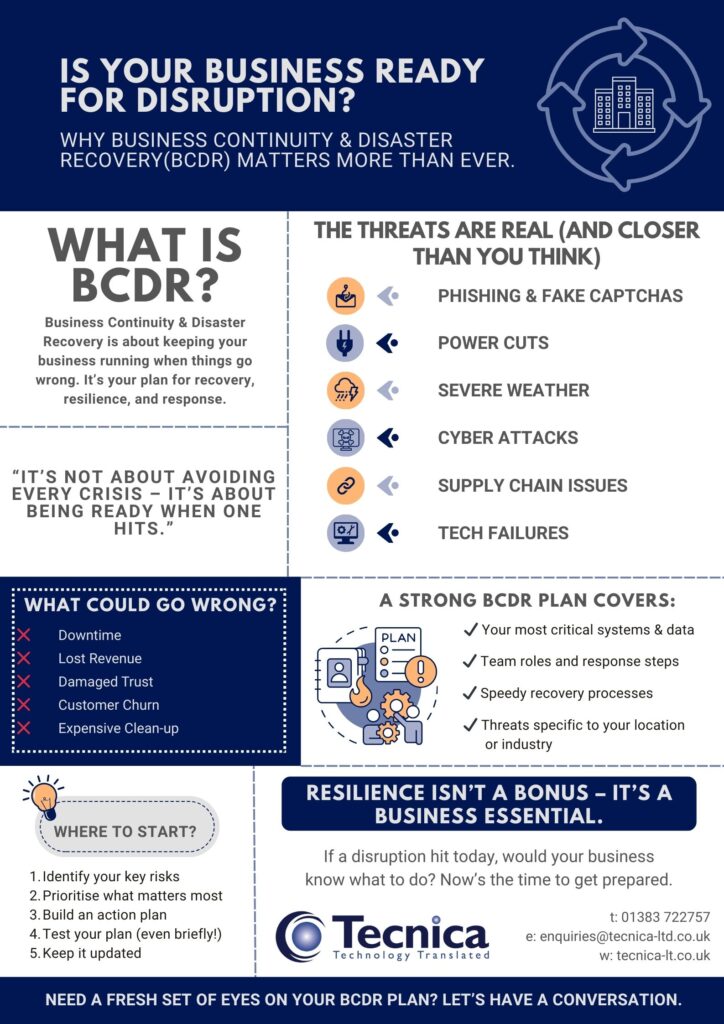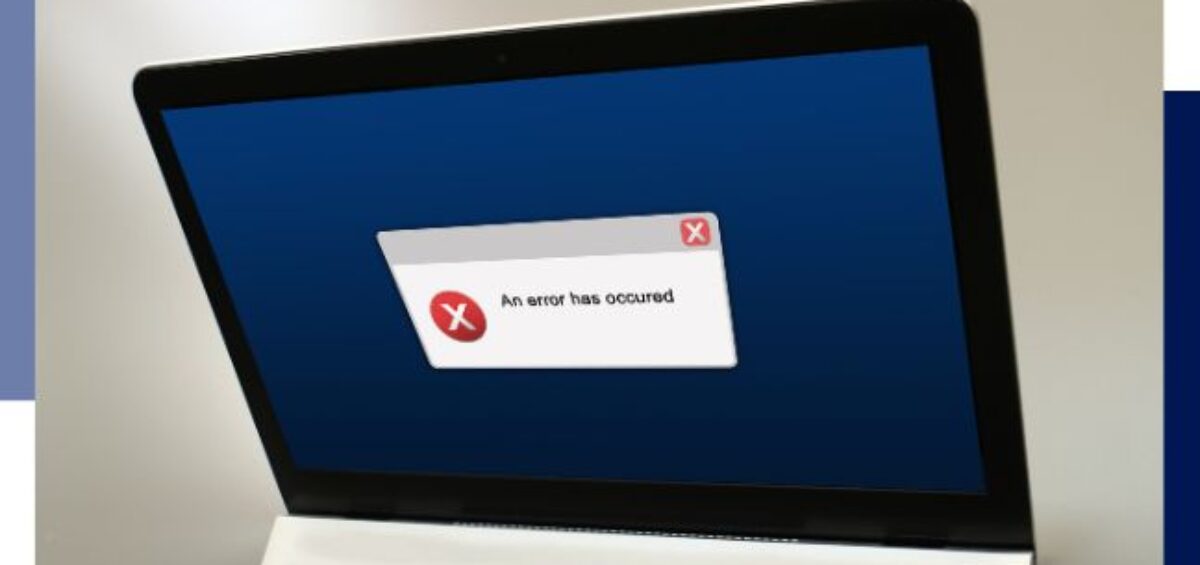When people think of disasters, they usually picture something dramatic — floods, fires, or cyberattacks. But some of the most serious risks to business continuity fly under the radar. They’re slow, quiet, and often go unnoticed until systems fail, or operations grind to a halt.
A failed patch that corrupts your CRM. A switch failure that knocks out your phones. A key supplier that disappears without warning.
These incidents rarely make headlines — but they can bring your operations to a halt.
And without a strong continuity strategy in place, even a minor disruption can spiral quickly.
With systems more interconnected than ever, small failures now carry far-reaching consequences.
Heathrow’s Wake-Up Call: When “Business as Usual” Isn’t
Take Heathrow Airport. A recent fire in a nearby data centre triggered widespread delays across multiple terminals. But the fire wasn’t the real problem — the lack of resilient power systems was.
It was a clear example of what happens when continuity planning is incomplete or untested. Thousands of passengers were affected. Operations ground to a halt.
It wasn’t a cyberattack or a large-scale natural disaster. It was a local issue — with national impact.
If a business with Heathrow’s resources can get caught out, what does that mean for organisations without a robust Business Continuity and Disaster Recovery (BCDR) plan?
The Everyday Failures That Cause Big Problems
The most damaging risks to business continuity often come from quiet failures — the ones that build slowly, go undetected, or happen at the worst possible time.
Hardware: Small Parts, Big Problems
Despite the rise of cloud services, hardware failures are still a leading cause of downtime. Old servers and storage devices are often kept running well beyond their intended lifespan — until they fail at the worst possible time.

A single drive failure might seem minor. But it can lead to corrupted data, hours of lost productivity, and a full system rebuild if backups aren’t current or recoverable.
Ask yourself: How much data can you afford to lose?
An hour’s worth? A day? A week?
Without the right backup and recovery processes in place, even a routine failure can turn into a major risk to business continuity.
When Suppliers Become Points of Failure
Most businesses now rely on third-party platforms — from logistics and payments to customer support portals. But if those providers go down, so do you.
More importantly: Do you know if your suppliers have their own continuity plans?
You might not be able to prevent their outages — but you can prepare for the impact. BCDR means having contingency measures in place: fallback providers, alternative workflows, and clear communication with your customers.
When Trusted Tools Go Wrong: The Microsoft Windows Upgrade Incident
In April 2025, a flaw in Microsoft Intune caused some Windows 10 devices to upgrade to Windows 11 — despite policies in place to block the change.
There was no breach. No hardware fault. Just a silent failure in a trusted system — and hours of manual rollback and recovery for IT teams.
And it highlights an uncomfortable truth: you don’t need to own the risk for it to affect you. If you’re relying on third-party tools, their failures can become your problem fast.
The Risks of Poor Backup Management: When ‘Reliable’ Isn’t Enough
Backups often sit in the background — until they’re suddenly critical.

But as data volumes grow, backup systems become harder to manage, more prone to silent failure, and slower to restore. The risks of poor backup management go beyond lost files — they can lead to costly downtime, failed recovery efforts, and lasting reputational damage.
Alarmingly, many organisations don’t realise their backups have failed until they need them.
A strong BCDR plan makes backup a priority — not just in theory, but in practice. That means regular testing, recovery aligned to business requirements, and confidence that your data is there when you need it most.
If your backups aren’t tested or aligned with your business requirements, they become a silent risk to business continuity.
The Real Cost of Downtime
Disruption isn’t just inconvenient — it’s often damaging. The longer it takes to recover, the harder it becomes to retain customers, maintain trust, and keep revenue flowing. Some businesses never fully bounce back after a major disruption — not because the damage was irreversible, but because recovery took too long.
BCDR isn’t about reacting. It’s about being ready to respond — and recover — without missing a beat.
Is Your Strategy Ready for the Next Disruption?
Pressure-test your current plan with a few simple questions:
- If one of your key systems failed tomorrow, how quickly could you switch to a backup?
- How much data could you lose without serious impact — a few hours, or a few days?
- Are your backups tested regularly — and recoverable in line with your actual needs?
- Do you know whether your suppliers have a continuity strategy? And how would their downtime affect yours?
If those answers aren’t clear — now’s the time to reassess with expert support through our IT Consultancy Services.

Exceeding BCDR — And How We Help
BCDR shouldn’t just focus on recovery — it should ensure continuity from the outset and avoid the risks of poor backup management.
At Tecnica, we go beyond the baseline. Our focus is on practical, sustainable resilience — solutions that are maintained, monitored, and matched to your organisation’s needs.
We deliver infrastructure that holds up under pressure, backups that align with real recovery objectives, and clear visibility of risk before it becomes an issue. Our use of hybrid cloud for disaster recovery allows you to maintain continuity even when local systems fail.
From hybrid cloud to on-premise systems, our approach stays flexible, future-ready, and focused on keeping you operational.
Why Hybrid Cloud for Disaster Recovery Is a Game-Changer
More organisations are now turning to hybrid cloud for disaster recovery — using it as a flexible, scalable foundation for business continuity.

By combining on-site systems with cloud-based recovery, hybrid cloud offers the best of both worlds. You keep running your core services locally — while using the cloud for backups, failover, and remote access.
If your local systems fail, you’re not left waiting for replacement hardware. You keep going.
And because hybrid cloud models are scalable, they’re just as effective for SMEs as they are for large enterprises.
Final Thought
At Tecnica, we believe BCDR should be more than a checkbox. It should be a working, flexible strategy that grows with your business.
We help you identify risk, simplify recovery, and stay one step ahead — whatever happens.
And because we’re vendor-agnostic, our solutions are built around you — not someone else’s roadmap.
Downtime is inevitable. Disruption isn’t.
Start planning for the outage before it happens — not after.
Let’s build continuity you can count on.
We Recommend:
- Cyber Security
- How Stronger Cyber Security Can Protect Your Business From Data Breaches
- Social Engineering Attacks: Why Businesses Must Strengthen Their Defences in 2025
- BCDR – Cloud Services
- Why an Email Security Policy Matters at Work
- Maximising Cost Savings and ROI: Benefits of Managed IT Services for business efficiency
Contact Us
Follow us on:


